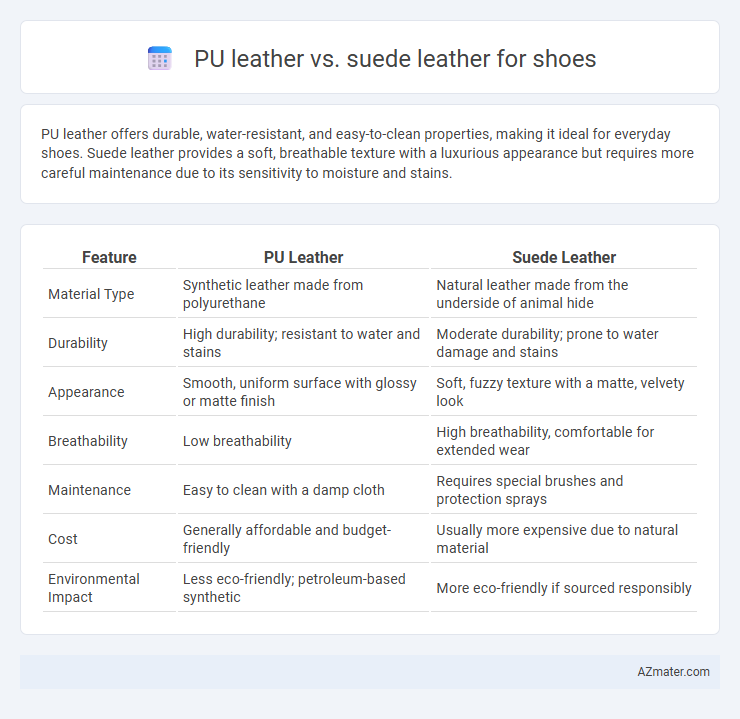PU leather offers durable, water-resistant, and easy-to-clean properties, making it ideal for everyday shoes. Suede leather provides a soft, breathable texture with a luxurious appearance but requires more careful maintenance due to its sensitivity to moisture and stains.
Table of Comparison
| Feature | PU Leather | Suede Leather |
|---|---|---|
| Material Type | Synthetic leather made from polyurethane | Natural leather made from the underside of animal hide |
| Durability | High durability; resistant to water and stains | Moderate durability; prone to water damage and stains |
| Appearance | Smooth, uniform surface with glossy or matte finish | Soft, fuzzy texture with a matte, velvety look |
| Breathability | Low breathability | High breathability, comfortable for extended wear |
| Maintenance | Easy to clean with a damp cloth | Requires special brushes and protection sprays |
| Cost | Generally affordable and budget-friendly | Usually more expensive due to natural material |
| Environmental Impact | Less eco-friendly; petroleum-based synthetic | More eco-friendly if sourced responsibly |
Introduction to PU Leather and Suede Leather
PU leather, a synthetic material made by coating a fabric base with polyurethane, offers durability, water resistance, and affordability, making it a popular choice for shoe manufacturing. Suede leather, derived from the underside of animal hides, features a soft, napped texture prized for its luxurious appearance and breathability but requires careful maintenance due to its susceptibility to water and stains. Choosing between PU leather and suede leather for shoes involves balancing factors such as cost, durability, aesthetic appeal, and ease of care.
Material Composition: PU Leather vs Suede Leather
PU leather is a synthetic material made from a split leather backing coated with a polyurethane layer, offering water resistance and easy maintenance, while suede leather is crafted from the underside of animal hide, resulting in a soft, napped finish with a porous texture that is less water-resistant and more prone to staining. The polyurethane in PU leather provides durability and flexibility, making it suitable for budget-friendly, low-maintenance shoes, whereas suede leather's natural fiber composition delivers superior breathability and an elegant appearance but requires more care. Material composition differences significantly impact the shoe's performance, durability, and maintenance, with PU leather favored for its synthetic durability and suede prized for its luxurious feel and natural origin.
Durability and Longevity in Footwear
PU leather offers superior durability and water resistance compared to suede leather, making it more suitable for everyday footwear exposed to moisture and abrasion. Suede leather, while softer and more breathable, tends to wear out faster and is more prone to staining and damage from environmental factors. For long-lasting shoes, PU leather maintains structural integrity and appearance better under regular use.
Comfort and Breathability for Shoes
PU leather offers water resistance and durability but lacks breathability, making it less comfortable for prolonged wear compared to suede leather. Suede leather, made from the underside of animal hides, provides superior softness and natural breathability, enhancing foot comfort by allowing better air circulation. Shoes crafted with suede leather are preferred for comfort-focused applications where moisture management and flexibility are essential.
Aesthetic Appeal: Texture and Appearance
PU leather offers a smooth, glossy surface with a consistent finish, lending a sleek and polished look to shoes that is easy to maintain and resistant to stains. Suede leather features a soft, napped texture with a matte appearance, providing a rich, velvety aesthetic that adds depth and warmth to footwear. The tactile difference between PU leather's firm surface and suede's delicate fuzz creates distinct visual and textural appeal, influencing style choices based on preference for shine versus softness.
Maintenance and Cleaning Requirements
PU leather shoes require minimal maintenance, as they are water-resistant and can be easily cleaned with a damp cloth or mild soap solution, making them ideal for everyday use. Suede leather shoes demand more attention, needing specialized suede brushes and erasers to remove dirt and stains, and should be treated with waterproofing sprays to prevent damage from moisture. Regular maintenance is crucial for suede to maintain its texture and appearance, while PU leather offers more durability and effortless cleaning.
Cost Comparison: Affordable vs Premium Options
PU leather offers an affordable alternative to genuine suede leather, making it a popular choice for budget-conscious consumers. Suede leather is typically more expensive due to its natural materials and labor-intensive production, positioning it as a premium option in footwear. Cost differences between PU and suede directly impact product pricing and consumer preferences in the shoe market.
Environmental Impact and Sustainability
PU leather, a synthetic material made from polyurethane, generally has a lower environmental impact during production compared to traditional leather, as it avoids animal farming but relies on fossil fuels and chemicals, leading to concerns over non-biodegradability and microplastic pollution. Suede leather, derived from the underside of animal hides, involves livestock farming which contributes significantly to greenhouse gas emissions, land use, and water consumption, though it is biodegradable and often more durable, resulting in a longer lifespan for shoes. Sustainable shoe manufacturing increasingly favors recycled or plant-based PU alternatives and responsibly sourced suede combined with efficient tanning processes to mitigate environmental harm.
Best Uses: PU Leather Shoes vs Suede Shoes
PU leather shoes are ideal for everyday wear, offering water resistance and easy maintenance suitable for rainy or urban environments. Suede shoes excel in dry conditions, providing a soft texture and stylish appeal perfect for casual or formal outings. Choosing between PU leather and suede depends on the desired durability, weather resilience, and dress code requirements.
Choosing the Right Leather for Your Shoes
PU leather offers durability, water resistance, and easy maintenance, making it ideal for everyday shoes and those exposed to moisture. Suede leather provides a soft texture and breathability, creating a stylish, comfortable option that requires careful care to maintain its appearance. Choosing the right leather depends on usage, durability needs, and desired aesthetics, with PU leather suited for practicality and suede for luxury and casual wear.

Infographic: PU leather vs Suede leather for Shoe
 azmater.com
azmater.com